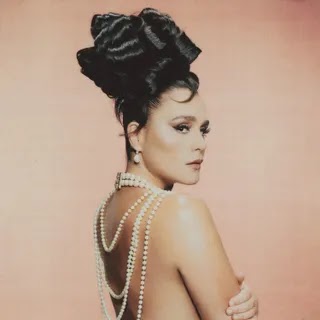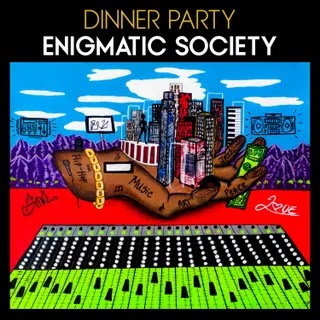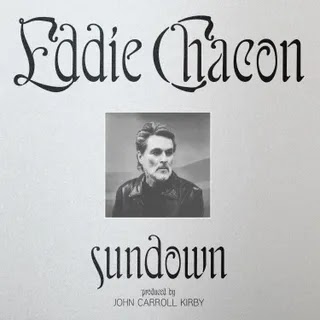In 1984, a teenaged sibling duo in Birmingham, England recorded their unique, Urdu-language take on synth pop. The first release from the Discostan label celebrates a lost classic of new wave.
Los Angeles artist Arshia Fatima Haq was thumbing through racks of dusty vinyl at New York’s A-1 Records a few years ago when a title caught her eye: Disco Se Aagay, or “Beyond Disco” in Haq’s native Urdu. Peering out from the sleeve was a teenage girl with bouffant ’80s hair, a white dinner jacket, and a Mona Lisa smile. The album was billed as “a step further in the field of disco music”; the musicians were identified in the credits as a brother and sister, Nermin Niazi and Feisal Mosleh, from Birmingham, England. Nermin, the singer and lyricist, was “still a school-girl,” according to the sleeve notes. Feisal, a college student, had composed and produced the music, writing some of the songs at just 17. The copyright was dated 1984; there were synthesizers. Naturally, Haq took the record home.
Since 2011, Haq, who was born in Hyderabad, India, had been developing a project called Discostan: a “diasporic discotheque” and radio show dedicated to the stories and sounds of the South and West Asian and North African (SWANA) region. She wanted to upend official narratives of nationhood, to decolonize popular music and the avant-garde alike. Exploring the idea of “home” from a diasporic perspective, her project was critical but also celebratory, designed to facilitate what she has called the “radical embodiment of marginalized people on the dancefloor.” As Haq listened to Disco Se Aagay, she was “blown away” by hearing a new-wave band singing in her mother tongue, she recently told Bandcamp Daily. She realized that the record spinning on her turntable was a physical manifestation of Discostan. Before long, she and her creative partner, Jeremy Loudenback, tracked down Niazi and Mosleh, now middle aged, to discuss a reissue.
The liner notes of Discostan Records 001 fill in the gaps of Nermin and Feisal’s story. They come from a musical family: Their grandfather had been the director of Radio India before Partition; their mother, Nahid Niazi, was a famous playback singer; their father, Moslehuddin, was a renowned film composer. The kids were born in Pakistan but grew up in Birmingham, England, where the family wound up after civil war erupted in their homeland in 1971. As a young teen, Nermin was enamored of the British synth pop that ruled the airwaves; Feisal liked to tinker on his father’s Casio and Yamaha keyboards. They ended up signing to Oriental Star Agencies, the Birmingham label that would popularize qawwali singer Nusrat Fateh Ali Khan in the West. The summer that they were 14 and 19, respectively, they went into Birmingham’s Zella Studios to record a batch of songs that fused synth pop, electro-funk, Western classical chord structures, and Hindustani vocal scales.
Disco Se Aagay’s nine songs (and two remixes) are immediately identifiable as products of their era. They’re propelled by spring-loaded drum machines and rubbery basslines, and fleshed out in the vivid tones of the top-of-the-line synths like the Roland Juno-60 and Yamaha DX7: synthetic brass stabs, harpsichord-like glissandi, and bright splashes of glassy color. You can hear echoes of early Depeche Mode in Mosleh’s staccato counterpoints and New Order in his insistent drum programming; many of his rhythms are steeped in the punchy syncopations of Latin freestyle artists like Shannon and Connie. The opulent timbres and chord progressions often recall contemporaries like ABC, the Human League, Howard Jones, and other acts pursuing a particularly baroque take on new wave. Despite the songs’ studio sophistication—speaking to Bandcamp Daily, the two musicians recalled multi-tracking Niazi’s voice, then panning the layers to suggest a whirlpool of sound—the results lack the polish of their big-budget peers’ output. During an instrumental passage in “Nazneen,” the chords and bassline occasionally clash, as though two mismatched snippets of tape had inadvertently been spliced alongside one another. But the slightly muddled sonics—and the duo’s autodidactic instincts—are a big part of the album’s charm. As often as new wave celebrated artifice, this music feels unusually sincere.
What especially distinguishes these songs as something out of the ordinary is Niazi’s singing. She has a slight, breathy voice, but what she lacks in power she makes up for in agility and sheer expressiveness. Whereas white British synth pop tended toward either perky major or brooding minor keys, Niazi’s slippery, melismatic phrases, based on Hindustani scales, make room for more ambiguous emotions. At any moment, a giddy melody might turn downcast. On “Chala Hai Akela,” she sounds almost uncannily like Cocteau Twins’ Elizabeth Fraser; the song’s acoustic guitar and hissing shakers even anticipate the glistening palette that Cocteau Twins would adopt later in the decade.
It’s clear that Niazi and Mosleh weren’t just imitating the synth pop of the day; their musical backgrounds enabled their own original take on it. In place of Western pop’s verse/chorus structures, Niazi’s lyrics employ intricate repetitions—sometimes line by line, sometimes breaking apart individual words into a dizzying stream of syllables. In “Nainan,” her refrain of “Nainan na na na na/Woh nainan na na na na” translates as something like, “Eyes-eye-eye-eye ey-eye/Those eyes-eye-eye-eye ey-eye.” Even for listeners who don’t understand the lyrics, there’s no mistaking the surfeit of emotion, a feeling so powerful it can barely be expressed. And while Niazi sometimes sings of glowing fireflies, glittering stars, and flowers blooming in her heart, her songwriting also betrays a wisdom beyond her years.
In song after song, Niazi dwells on distance: the ache of faraway lovers, the longing to be reunited, the soul mates who wonder, “What is our destination and when will we actually meet?” In “Sari Sari Raat,” she sings of two lovers too scared to share their feelings: “I didn’t say a word/You also stayed silent/And just like that, we lost the moment/You walked away without hearing me.” Even her brightest melodies sometimes contain dark recriminations: “You’re a liar and you hide/Pretending to be something else,” she sings on “Dekha Jab Se Dekha”; “Don’t come near me/What do you think this is?”
British new wave is typically framed as a story of the democratization of pop music—of floppy-haired kids poking away at second-hand synthesizers in their bedrooms, neophytes inventing a crude new musical language. As the Human League’s Phil Oakey joked, “We laughed at the other bands learning three chords—we used one finger.” Still, despite these democratic pretenses, the history of new wave has hardly been inclusive; the kids in its telling are almost invariably white. Disco Se Aagay challenges that assumed homogeneity. Along with other recent reissues from the Subcontinent and its diaspora, like Charanjit Singh’s prescient 1983 album Synthesizing: Ten Ragas to a Disco Beat and Rupa’s Disco Jazz, a crate-diggers’ holy grail that became a YouTube hit, Disco Se Aagay offers an important correction to the historical record. It is a reminder that some of pop culture’s most interesting artifacts emerge far from the floodlights of Top of the Pops (though Niazi and Mosleh did get to perform on the BBC’s Asian Magazine); it is a reminder of the diversity inherent to British culture, despite what the St. George’s flag-waving Brexiteers would like to believe. Above all, it is a reminder—and a joyful one—of the dualities experienced by people like Niazi and Mosleh, who grew up straddling two cultures. As Haq would say, decades later, of her fictional Republic of Discostan, “Sound is the one thing that crosses borders…. Music is the bridge between these places, and a way of creating an imaginary homeland.”
















0 comments:
Post a Comment